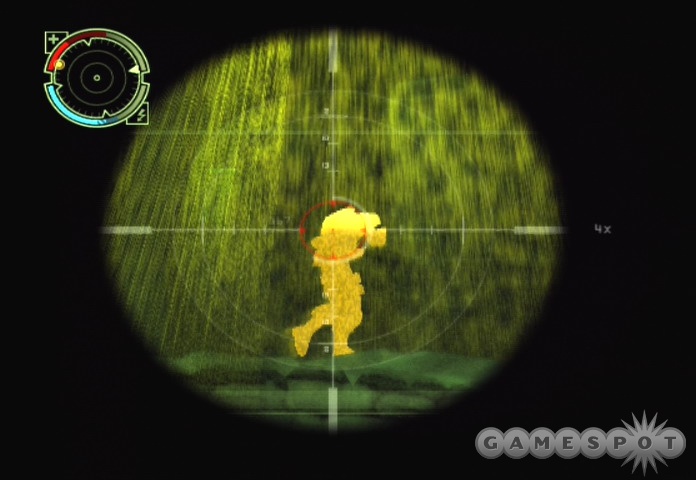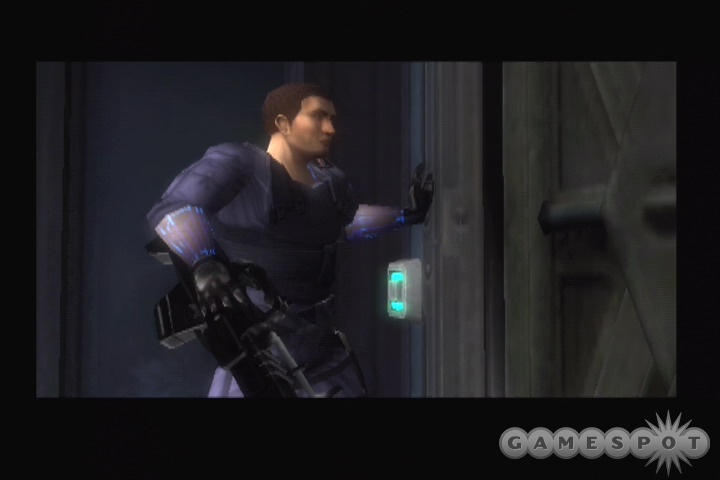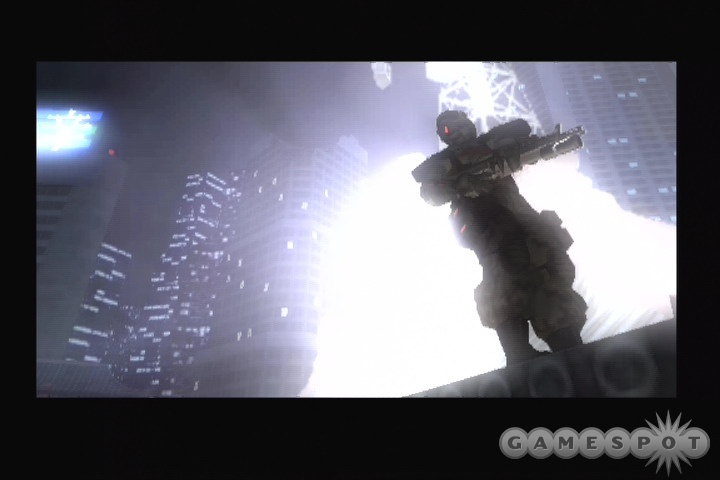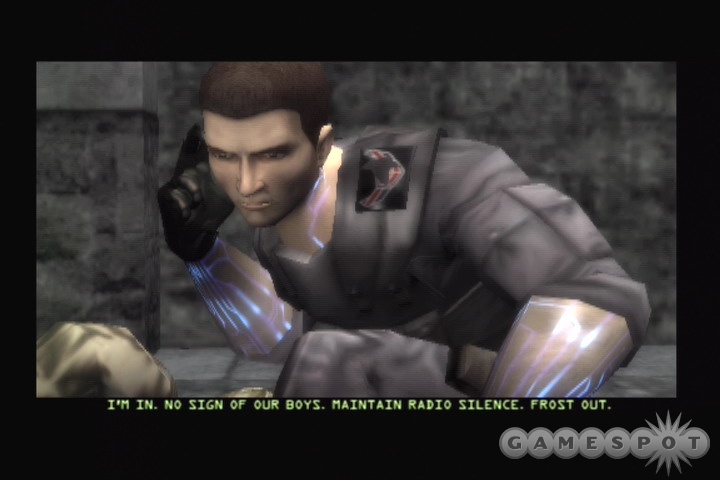Project: Snowblind started its life as a Deus Ex spin-off, with the purpose of capitalizing on that universe's rich fiction and distinct style by pairing it with a more visceral gameplay experience. Despite the fact that Project: Snowblind bears no official Deus Ex ties now, the game brandishes an almost identical near-future cyber-thriller feel, right down to the eerie blue circuit-board highlights on the hero's skin. Crystal Dynamics doesn't reinvent the first-person shooter with Snowblind, but that doesn't seem to be its aim anyway. Rather, it delivers a solid, fast-paced experience that provides a nice balance between the fresh and the familiar.

Project: Snowblind borrows liberally from highly recognizable sources, an ethos which might as well be written in the design documents for most modern first-person shooters. As mentioned before, the game's look owes a lot to Deus Ex, though because the action's set in a war-torn near-futuristic Hong Kong, there's a bit more overt Asian influence, both ancient and modern. Still, the philosophy of contrasting the old and the new is hard at work here, creating a look that's a bit more steely and streamlined than what typified Blade Runner. Expect to see a lot of near-futuristic military hardware couched in dilapidated industrial complexes, blown-out urban centers, and--in one of the game's more visually stunning pieces--in a massive domed opera house that's been hastily converted in to a POW camp.
The game's unwavering devotion to this specific aesthetic goes far in establishing Snowblind's overall vibe, as does an almost fetish-level concentration of filtered lighting effects. There's a soft-glow effect at work for virtually the entire run of the game, which cleverly smoothes out the hard edges while creating a tangible atmosphere. There's a unique effect associated with every one of your special abilities, each of which can change the entire look of the game. The titular "snowblind" effect is especially well done, though considering the harrowing situations when it usually comes up, you'll likely be too freaked-out to really sit back and appreciate it.
By limiting the size of the levels, Snowblind is able to keep the visual quality high, often lending a claustrophobic feel to portions of the game. There are some repetitive pieces, and some of the enemy death animations start getting tiresome almost as soon as you see them, but this is still a really sharp-looking game...especially for the aging PlayStation 2 hardware. Surprisingly, the Xbox version carries no visual advantage over the PlayStation 2 version. In fact, we noticed a less-stable frame rate on the Xbox, though the Xbox hard drive made much shorter work of load times and game saves.

Wrapped around all this glimmer is a by-the-numbers backstory, complete with a grimly stoic hero, unwelcome invasions, vaguely defined military coalitions, and everyone's favorite deus ex machina, a doomsday device that could go at any second. Some story gets crammed in to the margins during in-game cutscenes between levels, and these sequences are brimming with plenty of gravelly, hard-boiled dialogue. The game itself is peppered pretty freely with the idle conversations of bystanding characters, à la Half-Life. It's an old trick, but it's an effective one for fleshing out the world in a casual manner. Moreover, the quality of the voice acting helps sell it.
The build of the sound isn't quite as unique or specifically designed as Project: Snowblind's visuals, but it's still a solid foundation of gunfire and explosions, accented by a variety of electronic pips, chirps, and hisses produced by machinery both inside and outside of your cybernetically augmented head. Music comes in when it needs to, whether it's to build tension during a quiet stealth mission or to add some extra punch to a firefight. Again, there's a distinct Asiatic feel to the music, so you can almost anticipate the falling of cherry blossoms when the score kicks in at some points.
The game is more concerned with satisfying firefights and fast pacing than it is tactical complexity. Most of your core weapons are pretty standard, though the electromagnetic pulse rifle is kind of novel, letting you fire at one enemy and having the electrical pulse automatically link itself to other nearby enemies. Grenades come in a variety of flavors, and there are more inventive pieces of hardware you can deploy in combat, too, such as a friendly robotic spider or a stationary force field for instant cover from enemy fire.

If that's not cyberpunk enough for you, you'll regularly come across security panels and pieces of machinery that you can hack in to and then take control of. Sometimes hacking is necessary to advance, and sometimes it can just make your day a little less hectic. Either way, it seems a little too easy, because you just shoot the device you want to hack with your special "ice pick" weapon, and presto! You've got complete control over a small security network or perhaps a heavily armed robot.
But any first-person shooter hero can squeeze a trigger, and what makes you really special are your unique abilities. You kick things off with the ability to switch your eyesight to "enhanced vision," which works sort of like a cross between infrared, night, and X-ray vision. Soon, though, you'll be able to slow down time, coat yourself in an impenetrable shield, turn yourself completely invisible, or fry enemies with a devastating electrical attack. These admittedly potent abilities are tempered with a fast-depleting energy bar that you'll need to replenish with special pickups. This bag of tricks is one of the more unique aspects of Project: Snowblind, and your special powers can be awful fun to use. Having to cycle through them using just the left direction on the D pad, though, can be incredibly frustrating in a firefight. Even still, it's hard to consider a more elegant or functional solution than what Crystal D. came up with here.
Firefights dominate the gameplay, though there are ostensibly stealth-based missions as well. Stealth is more of a suggestion than a hard-and-fast rule here, and you'll have an easier (read: more boring) time if you make smart use of your cloaking ability. Considering all the heavy-handed yet poorly implemented stealth mechanics we've seen in the past, it's pleasant to be able to forgo the stealth altogether without insurmountable penalties. On the rarest of occasions, you'll even get to pilot some kind of vehicle, like perhaps a walking tank or maybe just a heavily armored car. And despite sometimes bearing the clunkiness of an afterthought, these moments help flesh out the world, making it feel more complete.

The single-player game really seems to fly by, wrapping up nicely after a good 10 hours. There's a nice multiplayer component to Project: Snowblind, too, which can be played either over the Internet or over a LAN with up to 16 players. Meanwhile, single-system multiplayer is a no-go, much to the disappointment of split-screen masochists everywhere. But seriously, the maps are so attuned to the maximum capacity of 16 players that four-player split-screen would be worse than boring. You can tune your online experience in a variety of ways. There are several deathmatch and capture the flag variants to choose from, and you can also pick a different weapon loadout for your character every time you respawn. The game allows some other minor tweaks as well, and though it's no Halo 2, the multiplayer in Project: Snowblind seems fun and functional, with enough customization options to get your money's worth. Considering the relative lack of great multiplayer shooters on the PlayStation 2, Project: Snowblind's one of the best things going online.
So if you liked the look and feel of the Deus Ex games but couldn't get past the clunky combat, or if you just don't dig the whole role-playing-game thing, Project: Snowblind is just perfect for you. It's unlikely that Project: Snowblind will completely destroy you, because its pieces are a little too common to incite a paradigm shift. But the pieces are well conceived, and they're effectively assembled into a fast-paced and easy-to-get-into shooter with action that's responsive and just unique enough to entertain.



